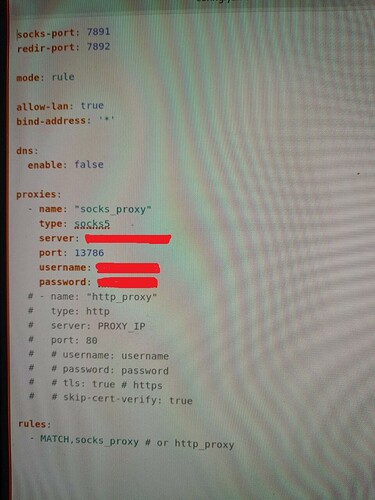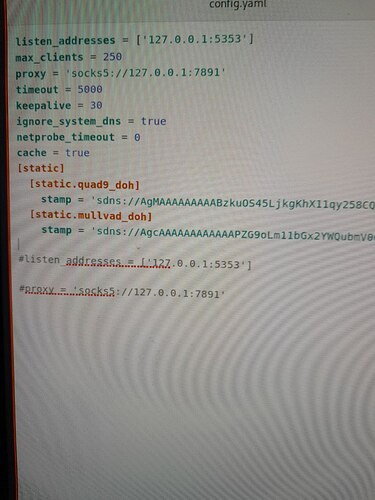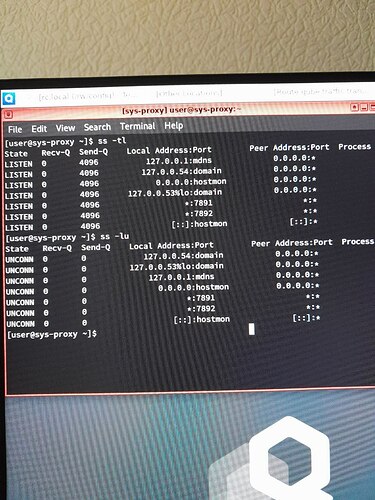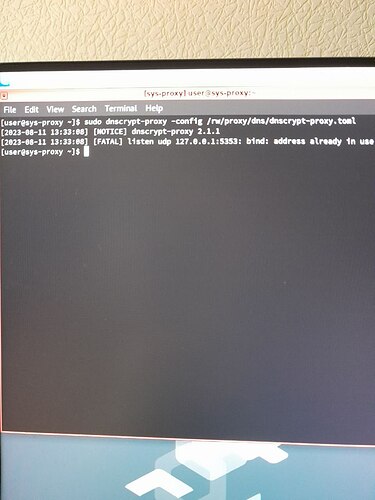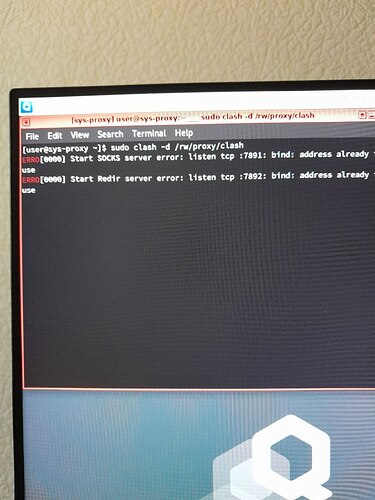Introduction
This guide describes setting up a sys-proxy qube, which will transparently route the traffic of qubes using it as their networking qube through a SOCKS5, HTTP(S) or other supported proxy.
Requirements
- Qubes OS R4.1 or R4.2
- A proxy server (SOCKS5, HTTP(S), Shadowsocks)
Setup
Setting up the template
We’ll be using a minimal Fedora template. To install it, run in dom0:
sudo qubes-dom0-update qubes-template-fedora-38-minimal
After it has finished installing, open the Qubes update tool in dom0, enable Enable updates for qubes without known available updates, check fedora-38-minimal and hit next, wait for it to finish updateing.
Open Qube Manager, find fedora-38-minimal, right-click it, choose Clone qube, name it fedora-38-minimal-proxy and hit OK.
Open a terminal window in dom0, open up a root terminal in the cloned template:
qvm-run -u root fedora-38-minimal-proxy xterm
Install the necessary software in the template by running in the opened terminal window of the template:
dnf install qubes-core-agent-networking iproute clash dnscrypt-proxy
systemctl disable dnscrypt-proxy
poweroff
Creating sys-proxy qube
Open the Qube creation tool and configure the qube as follows:
- Name: sys-proxy
- Type: AppVM
- Template:
fedora-38-minimal-proxy - Networking: this is for you to decide, perhaps you want to use a VPN qube, default is
sys-firewall
Tick Launch settings after creation and hit OK
Select tab Advanced, tick Provides network
click Apply and then OK
Launch a terminal in dom0 and run:
qvm-firewall sys-proxy del --rule-no 0
qvm-firewall sys-proxy add drop
qvm-firewall sys-proxy add --before 0 drop proto=icmp
qvm-firewall sys-proxy add --before 0 drop specialtarget=dns
qvm-firewall sys-proxy add --before 0 accept PROXY_IP
qvm-firewall sys-proxy
replace PROXY_IP with your proxy’s IP
last command should show accept → drop DNS → drop ICMP → drop
Configuring sys-proxy qube
Open sys-proxy’s terminal by running in dom0:
qvm-run -u root sys-proxy xterm
In sys-proxy’s terminal run: mkdir -p /rw/proxy/dns /rw/proxy/clash
Edit /rw/proxy/dns/dnscrypt-proxy.toml in sys-proxy and add:
listen_addresses = ['127.0.0.1:5353']
max_clients = 250
proxy = 'socks5://127.0.0.1:7891'
timeout = 5000
keepalive = 30
ignore_system_dns = true
netprobe_timeout = 0
cache = true
[static]
[static.quad9_doh]
stamp = 'sdns://AgMAAAAAAAAABzkuOS45LjkgKhX11qy258CQGt5Ou8dDsszUiQMrRuFkLwaTaDABJYoSZG5zOS5xdWFkOS5uZXQ6NDQzCi9kbnMtcXVlcnk'
[static.mullvad_doh]
stamp = 'sdns://AgcAAAAAAAAAAAAPZG9oLm11bGx2YWQubmV0Ci9kbnMtcXVlcnk'
Edit /rw/proxy/clash/config.yaml in sys-proxy and add:
socks-port: 7891
redir-port: 7892
mode: rule
allow-lan: true
bind-address: '*'
dns:
enable: false
proxies:
- name: "socks_proxy"
type: socks5
server: PROXY_IP
port: 1080
# username: username
# password: password
# - name: "http_proxy"
# type: http
# server: PROXY_IP
# port: 80
# # username: username
# # password: password
# # tls: true # https
# # skip-cert-verify: true
rules:
- MATCH,socks_proxy # or http_proxy
Replace PROXY_IP and with your proxy’s IP, modify proxy settings as needed
For Qubes R4.1
Edit /rw/config/rc.local in sys-proxy and add:
sysctl -w net.ipv4.conf.all.route_localnet=1
iptables -I FORWARD -o eth0 -j DROP
iptables -I FORWARD -i eth0 -j DROP
ip6tables -I FORWARD -o eth0 -j DROP
ip6tables -I FORWARD -i eth0 -j DROP
iptables -P OUTPUT DROP
iptables -A OUTPUT -m state --state RELATED,ESTABLISHED -j ACCEPT
iptables -A OUTPUT -o lo -j ACCEPT
iptables -A OUTPUT -d PROXY_IP -j ACCEPT
iptables -t nat -F PR-QBS
iptables -t nat -A PR-QBS -d 10.139.1.1 -p udp --dport 53 -j DNAT --to 127.0.0.1:5353
iptables -t nat -A PR-QBS -d 10.139.1.1 -p tcp --dport 53 -j DNAT --to 127.0.0.1:5353
iptables -t nat -A PR-QBS -d 10.139.1.2 -p udp --dport 53 -j DNAT --to 127.0.0.1:5353
iptables -t nat -A PR-QBS -d 10.139.1.2 -p tcp --dport 53 -j DNAT --to 127.0.0.1:5353
iptables -t nat -A PREROUTING -i vif+ -p udp -j REDIRECT --to-ports 7892
iptables -t nat -A PREROUTING -i vif+ -p tcp -j REDIRECT --to-ports 7892
iptables -I INPUT -i vif+ -p tcp --dport 7892 -j ACCEPT
iptables -I INPUT -i vif+ -p udp --dport 7892 -j ACCEPT
iptables -I INPUT -i vif+ -p tcp --dport 5353 -j ACCEPT
iptables -I INPUT -i vif+ -p udp --dport 5353 -j ACCEPT
clash -d /rw/proxy/clash >/dev/null 2>&1 &
sleep 0.5
dnscrypt-proxy -config /rw/proxy/dns/dnscrypt-proxy.toml >/dev/null 2>&1 &
Replace PROXY_IP and with your proxy’s IP
For Qubes R4.2
Edit /rw/config/rc.local in sys-proxy and add:
sysctl -w net.ipv4.conf.all.route_localnet=1
nft 'add rule ip qubes custom-forward oifname "eth0" drop'
nft 'add rule ip6 qubes custom-forward oifname "eth0" drop'
nft 'add rule ip qubes custom-forward iifname "eth0" drop'
nft 'add rule ip6 qubes custom-forward iifname "eth0" drop'
nft flush chain ip qubes dnat-dns
nft 'add rule ip qubes dnat-dns ip daddr 10.139.1.1 udp dport 53 dnat to 127.0.0.1:5353'
nft 'add rule ip qubes dnat-dns ip daddr 10.139.1.1 tcp dport 53 dnat to 127.0.0.1:5353'
nft 'add rule ip qubes dnat-dns ip daddr 10.139.1.2 udp dport 53 dnat to 127.0.0.1:5353'
nft 'add rule ip qubes dnat-dns ip daddr 10.139.1.2 tcp dport 53 dnat to 127.0.0.1:5353'
nft 'add rule ip qubes custom-input iifname "vif*" tcp dport 7892 accept'
nft 'add rule ip qubes custom-input iifname "vif*" udp dport 7892 accept'
nft 'add rule ip qubes custom-input iifname "vif*" tcp dport 5353 accept'
nft 'add rule ip qubes custom-input iifname "vif*" udp dport 5353 accept'
nft 'add chain ip qubes redir { type nat hook prerouting priority -99 ; policy accept; }'
nft 'add rule ip qubes redir iifname "vif*" ip protocol udp redirect to :7892'
nft 'add rule ip qubes redir iifname "vif*" ip protocol tcp redirect to :7892'
nft 'add chain ip qubes output { type filter hook output priority filter ; policy drop; }'
nft 'add rule ip qubes output ct state related,established accept'
nft 'add rule ip qubes output oifname "lo" accept'
nft 'add rule ip qubes output ip daddr PROXY_IP accept'
clash -d /rw/proxy/clash >/dev/null 2>&1 &
sleep 0.5
dnscrypt-proxy -config /rw/proxy/dns/dnscrypt-proxy.toml >/dev/null 2>&1 &
Replace PROXY_IP and with your proxy’s IP
End of Qubes version specific instructions
Download Country.mmdb from here in another qube, move it to sys-proxy’s /rw/proxy/clash directory.
It doesn’t actually get used, but the proxy client refuses to start without it, meaning it doesn’t have to be kept up-to-date.
Last but not least, restart sys-proxy!
Using sys-proxy
After having restarted sys-proxy, you can create a new qube that uses sys-proxy as its networking qube.
To test if it’s indeed working, in the new qube curl https://ip.me should show the proxy’s IP address.
Notes
-
clash, the proxy client used, also supports other proxy protocols such as Shadowsocks in addition to SOCKS5 and HTTP(S), see their documentation for more details. -
dnscrypt-proxy, the DNS client used, is being used with a minimal configuration that has two preconfigured DNS servers: Quad9’s and Mullvad’s DoH servers. You can also configure sources for lists of DNS servers, but make sure to preserve the custom configuration in ourdnscrypt-proxy.tomlfile (before[static]). See their documentation and example config file for details. - It should be leak-proof, since
qvm-firewallis used to block all traffic of all kinds fromsys-proxyto any non-proxy IPs.

